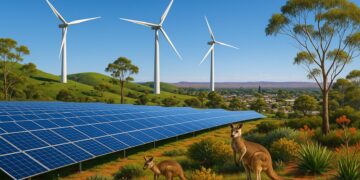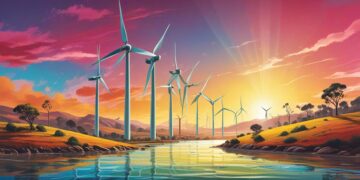Investing in Renewable Energies: The Future of the Sector in Australia

Leading the Renewable Energy Charge
Australia is experiencing a burgeoning shift towards renewable energy, positioning itself as a global pioneer in sustainable practices. With its extensive natural resources, the nation boasts a robust investment environment tailored to renewable technologies. This trend not only aligns with environmental goals but also supports economic growth and energy independence. Key sectors poised for significant investment further bolster this green initiative.
Solar Energy
In the context of solar energy, Australia shines brightly. With the highest average solar radiation per square meter globally, it has emerged as a leader in solar photovoltaic (PV) installations. Notably, the country has over 3 million solar energy systems installed on residential rooftops, generating approximately 12.2% of the nation’s electricity in 2021 alone. The situation is bolstered by government incentives such as the Small-scale Renewable Energy Scheme (SRES), which provides financial support for households willing to adopt solar technology.
Wind Energy
Wind energy is another critical component of Australia’s renewable landscape. Wind farms located in regions like Tasmania and South Australia thrive on steady wind patterns, contributing to the country’s goal of achieving 50% renewable energy by 2030. For instance, the Hornsdale Wind Farm in South Australia has an installed capacity of approximately 315 MW, making it one of the largest and most efficient wind farms in the country. This facility alone has significantly reduced reliance on fossil fuels and has become a model for future projects.
Hydropower
Hydropower also plays a crucial role in Australia’s renewable energy mix. While the country has long-established large-scale facilities like the Snowy Mountains Scheme, which generates around 4,500 MW, there is an increasing focus on small-scale hydropower projects. These newer initiatives not only harness local water resources but also support regional communities by providing job opportunities and contributing to energy security.
Battery Storage
As Australia invests in increasing its renewable energy generation, the importance of energy storage cannot be overstated. Innovative technologies in battery storage are essential for addressing the intermittency of solar and wind energy. Projects like the Tesla Hornsdale Power Reserve have demonstrated the efficacy of battery solutions in stabilizing the grid and optimizing energy usage. The reserve, which initially began with a 100 MW installation, has expanded in response to the increasing demands for reliable energy storage across the region.
Government Support and Future Opportunities
Supporting this renewable energy narrative are various government policies and ambitious initiatives. The Australian government aims to achieve net-zero emissions by 2050, a move that resonates with both local and international climate commitments. This direction not only signifies a commitment to environmental stewardship but also represents a fertile ground for investors. As the global demand for clean energy grows, Australia’s renewable energy sector presents a compelling opportunity for financial investment.
The strategic focus on innovation and sustainability means that investors are increasingly recognizing renewable energy as a viable and profitable avenue. With the right support, Australia is well-positioned to lead the way in the global shift towards sustainable energy solutions, paving the path for economic growth while addressing climate change challenges.
CHECK OUT: Click here to explore more
The Economic Landscape of Renewable Energy Investment
The shift towards renewable energy in Australia is not merely a response to environmental needs but a robust economic opportunity. As global markets increasingly turn their attention to sustainability, Australia’s unique geographical advantages position it favorably for both domestic and international investors. The significant variation in resource availability across the vast continent enables a diversified approach to renewable energy generation, ensuring reduced risks associated with dependence on a single energy source.
Investment Drivers
Several factors drive investment in the renewable energy sector in Australia:
- Government Policy Support: Australian policies, such as the Renewable Energy Target (RET), encourage the adoption of renewable sources by providing financial incentives, which inject capital into the sector.
- Technological Advancements: Continuous innovation in renewable technologies reduces the cost of energy production. The decrease in the price of solar PV systems by over 80% since 2010 exemplifies this progress.
- Rising Energy Costs: Increasing electricity prices in traditional energy markets incentivize the shift to more affordable renewable sources, further driving investment potential.
- Climate Goals: The commitment to achieving net-zero emissions by 2050 compels both public and private sectors to allocate resources towards renewable energy, creating myriad investment opportunities.
Market Potential and Growth Projections
The commitment to a renewable energy future implies a significant market potential. According to the Clean Energy Council, Australia’s renewable energy generation is expected to increase to 82% by 2030. This projection underscores the immense opportunities for investors willing to engage in initiatives focusing on solar, wind, and battery storage technologies. Furthermore, the demand for sustainable energy is expected to heighten in the coming years as both residential and corporate sectors aim to lower their carbon footprints.
Initially dominated by solar and wind, emerging technologies, including green hydrogen and energy efficiency measures, present additional avenues for investment. With proper infrastructure and policy support, these technologies could transform the energy market, leading the way in decarbonizing the economy.
Regional Opportunities
Australia’s geographic diversity offers distinct regional opportunities for renewable energy investment:
- Queensland: With substantial solar resources, Queensland has become a hotspot for solar farm development, attracting both local and international players.
- Victoria: The state is focusing on increasing its wind energy capacity, with several projects in the pipeline aimed at meeting the state’s ambitious renewable energy targets.
- Western Australia: Given its vast land area and strong winds, the region is seeing a surge in interest for both onshore and offshore wind projects.
Ultimately, the future of renewable energy investment in Australia is closely linked to the deliberate and strategic efforts of the government, industry stakeholders, and private investors. As infrastructure develops and technology evolves, Australia stands poised to not only lead in renewable energy production but also to become a hub for innovative investment strategies in the sector.
SEE ALSO: Click here to read another article
Challenges and Considerations in Renewable Energy Investment
Despite the promising landscape for renewable energy investment in Australia, several challenges and considerations must be accounted for by potential investors. Addressing these concerns not only safeguards investment but also ensures a sustainable approach to developing renewable energy projects.
Regulatory and Policy Uncertainty
Investors often face regulatory and policy uncertainty that can affect the profitability and feasibility of renewable energy projects. Changes in government policies or subsidies are common, which can lead to fluctuations in the energy market and potential disruptions in cash flow. For instance, the Renewable Energy Target (RET) has undergone revisions that may alter the investment landscape. Investors must remain vigilant and adaptive to navigate these changes effectively.
Financing and Investment Models
The capital-intensive nature of renewable energy projects places significant importance on financing models. Traditional project financing may limit the pool of investors willing to participate due to perceived risks. Therefore, innovative financial mechanisms, such as green bonds and power purchase agreements (PPAs), are gaining momentum. Green bonds provide a dedicated financing source for projects with environmental benefits, while PPAs secure long-term revenue streams by locking in prices between energy producers and buyers.
Integration and Grid Stability
As renewable energy generation capacity increases, integrating these sources into Australia’s existing grid infrastructure poses another significant challenge. The intermittent nature of solar and wind energy necessitates advancements in energy storage solutions and grid management to ensure reliability. According to a report from the Australian Energy Market Operator (AEMO), a combination of energy storage, demand response, and flexible generation is critical to maintain grid stability as the share of renewable energy grows. Investments in battery technologies, pumped hydro storage, and microgrid systems are vital to address these challenges and enhance energy security.
Workforce Development and Skills Training
The rapid growth of the renewable energy sector necessitates a skilled workforce capable of managing and executing sustainable projects. A shortage of skilled employees in areas such as engineering, project management, and maintenance can hinder industry growth. Collaboration between educational institutions and industry stakeholders is essential to develop training programs that align with future job requirements. Investment in workforce development is not only beneficial for ensuring project success but also helps to foster public support for renewable energy initiatives.
Global Market Dynamics
Australia’s renewable energy sector does not operate in isolation; it is influenced by global market dynamics. As nations worldwide intensify their efforts to combat climate change, competition for technology, materials, and talent will escalate. Australia must position itself favorably in the global supply chain to attract investments. This may involve forging international partnerships, enhancing research and development capabilities, and engaging in collaborative projects focused on innovative renewable technologies.
In light of these challenges, a comprehensive and strategic approach will be required to unlock the full potential of renewable energy investments in Australia. Investors must actively engage with policymakers, industry peers, and educational institutions to ensure a well-rounded and successful transition to a sustainable energy future. Understanding these complexities will empower investors to make informed decisions that contribute to both economic growth and environmental stewardship.
CHECK OUT: Click here to explore more
Conclusion
In conclusion, investing in renewable energies represents a significant opportunity for Australia, driven by the country’s abundant natural resources and a growing demand for clean energy solutions. The transition towards renewable energy not only supports environmental sustainability but also positions Australia as a competitive player in the global energy market. By overcoming the regulatory hurdles, embracing innovative financing methods, and enhancing grid integration, investors can unlock substantial economic benefits while contributing to a greener future.
It is essential for stakeholders to engage in a collaborative approach, fostering partnerships that bridge the gap between government policy, market innovation, and skilled workforce development. Efforts to address the skills gap will ensure that Australia has the talent necessary to support the growth of this dynamic sector. Moreover, as global competition intensifies, Australia must proactively position itself in the international renewable supply chain to attract foreign investment, thereby enhancing its technological capabilities.
Ultimately, a proactive and strategic framework is crucial for the successful investment in renewable energies. By staying informed about market trends and actively participating in dialogues around policy and innovation, investors can not only secure profitable ventures but also drive forward the vision of a sustainable, energy-efficient Australia. The time to act is now, as the future of the sector—and indeed the future of Australia’s energy landscape—depends on the investments made today.

Beatriz Johnson is a seasoned financial analyst and writer with a passion for simplifying the complexities of economics and finance. With over a decade of experience in the industry, she specializes in topics like personal finance, investment strategies, and global economic trends. Through her work, Beatriz empowers readers to make informed financial decisions and stay ahead in the ever-changing economic landscape.






